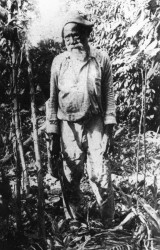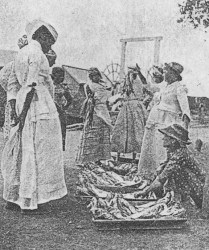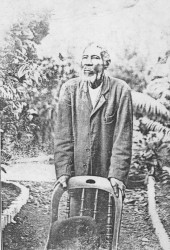By Cecilia McAlmont
This was first published by Stabroek News on May 26, 2011 as part of the ‘History This Week’ series.
The month of May is designated arrival month with May 5 the most important day. It is the day in 1838 when the first group of East Indian immigrants landed in British Guiana from the ship Whitby under what came to be known as the ‘Gladstone Experiment.’
Guyanese are also aware that like the East Indians, Portuguese immigrants from Madeira and China arrived at different periods to labour as indentures on the colony’s sugar plantations.

However, how many Guyanese, especially Guyanese of African descent are aware that a fourth category of indentured immigrants came from Africa? The purpose of this article is to inform Guyanese in general, and the people of African descent in particular about the participation of people of African descent in Guyana’s 19th century immigration schemes. Much of the information for this article is drawn from a book and article by Monica Schuler and articles by Anand James and Oswald Kendall.
Guyanese-born Monica Schuler in her book, Alas, Alas Kongo A social History of African immigration into Jamaica 1841-1865 stated: “Having officially forsworn slavery in 1834 and 1848 respectively, Britain and France cleverly exploited their own anti- slave trade efforts by ‘liberating’Africans from the slave trade and requiring them to migrate to the plantation colonies as indentured labourers.” Additionally, Colonial Secretary, Lord Stanley felt that the Africans liberated from slave ships would be “improved” by a temporary sojourn on the West Indian plantations.
Here is the most significant difference between the East Indian, Portuguese, Chinese and African indentured labourers who came to British Guiana and the Caribbean during the 19th century. Unlike the other three categories of immigrants who were citizens of countries who chose to, or were duped or cajoled into migrating, the African immigrants were persons who had been “liberated” from slave ships that were bringing them to the New World to be enslaved on
plantations in Brazil and Cuba. Having been liberated they were taken to holding stations mainly in Sierra Leone but also in St Helena, Rio de Janeiro and Nassau.
The purpose of acquiring indentured immigrants from all four sources was the same. It was to relieve the labour shortage that had come about as a result of the ex-slaves leaving the plantations at the end of apprenticeship. The planters were able to persuade the Colonial Office that without indentured immigrants the plantation economy would collapse and with it civilization in the colonies. Arguments similar to the ones used to justify the enslavement of Africans were now used to justify African indentures. Russell felt that “a regular intercourse between Africa and the West Indies would lead not only to the prosperity of the British West Indies but to the civilization of Africa.”
How the latter was to be achieved was not made clear, but in the case of the former, it was felt that an influx of Africans working voluntarily for wages would send a positive message to the ex-slaves that working for wages on the sugar estates was not so bad after all. Ex-slaves might thus be lured into returning to work on the plantations. More importantly, the presence of the African immigrants would certainly help to bring down the daily wage rate. Either way, the planter class would benefit.

Schuler, in her article Liberated Africans in 19th century British Guiana, stated that between 1840 and 1860, 52,000 voluntary and involuntary African immigrants were sent by the British and French to the Guianas and the West Indies. However, with specific reference to Guyana, she noted that the approximately 13,000 African indentured immigrants who came were an insignificant five-and-a-half per cent compared to the more than a quarter of a million East Indian immigrants who eventually came to British Guiana. She also stated that more liberated Africans came to British Guiana than to either Trinidad or Jamaica and that few returned to Africa. The majority of the liberated Africans or re-captives arrived from Sierra Leone between 1841 and 1851; St Helena 1842 and 1865; from Rio de Janeiro between 1841 and 1852 and from Nassau, New Providence between 1837 and 1846. Other Africans were recruited from the Kru coast of Liberia between 1845 and 1853 and from the Cape Verde Islands in West Africa in the 1850s. Liberated African residents who lived in Sierra Leone and coastal Liberia were voluntary immigrants, while recent recaptives recruited from the above-mentioned depots had little say in their emigration and were involuntary immigrants.
To encourage the immigration of Africans to British Guiana bounties of $35 were offered for immigrants from Sierra Leone, St Helena and Rio de Janeiro and $25 from other parts of Brazil. According to Kendall, the first group of African indentured immigrants arrived in the colony on the merchant vessel Superior on May 24, 1841. They were only sent to estates which satisfied the strict conditions specified by Governor Henry Light which included an estate preferably near to the sea coast; the nearest of the estates to some place of worship, not more than 20 immigrants per estate and importantly, “Regard being had to the accommodation on the estate, it would be desirable to distribute the people as extensively as possible over the colony in order that any vicious or superstitious practices to which they might be addicted might not be perpetuated by their being kept together.”
They were therefore distributed as follows: Essequibo Coast ‒ Plantation Lima 17, Reliance 14, Hoff Van Aurich 8, Walton 8, Land of Plenty 17, Aberdeen 12 ‒ a total of 76. On the East Coast Demarara they were distributed as follows: Plantation Le Resouvenir 11, Helena 16, Enmore 17, Greenfield 13, Turkeyen 11, Annandale 16 and Dochfour 5 ‒ a total of 89. However, these first immigrants were not indentured and had the freedom to bargain for daily, weekly or monthly work and wages and were free to change employers. On September 22, 1841, the Superior returned to British Guiana with 225 immigrants who were advised by the governor to find work in the healthiest part of the colony.

Anand James posited that by the middle of the 1840s, it was realized that liberated Africans would not be the answer to British Guiana’s labour problems. In the first year of the scheme only 1,102 liberated Africans arrived in the colony compared with 4,297 Portuguese and 2,745 West Indians. Between 1846 and 1848, 24,848 immigrants arrived. Of this number, 11,025 were from India, 10,036 were from Madeira hence only 3,787 consisted of liberated Africans and West Indians. Additionally, six trips made by the transport ship Arabian to the colony brought only 652 liberated Africans. After that, the planters turned their attention to immigration from India which was clearly the more plentiful source. After 1850, the liberated Africans came in very small numbers. In 1852, the last set of 113 came from Rio and 140 came from Sierra Leone. However, small shiploads continued to arrive until 1865.
The British Guianese planters were able to enact tough labour laws to control the immigrant labour force. In 1848, three-year voluntary contracts existed but by 1854, the Colonial Office approved compulsory indentures for three years and by 1863 there was an extension of indentureship to five years. African indentured labourers faced the same conditions and were governed by the same laws as other indentured immigrants. As Anand James rightly concluded when the Colonial Office decided to allow the emigration of liberated Africans to the West Indies in 1841, it initiated a process that was not unfamiliar in the history of British Guiana because the powerful planters had once again managed to get what they wanted.








